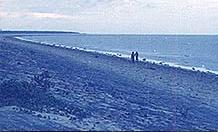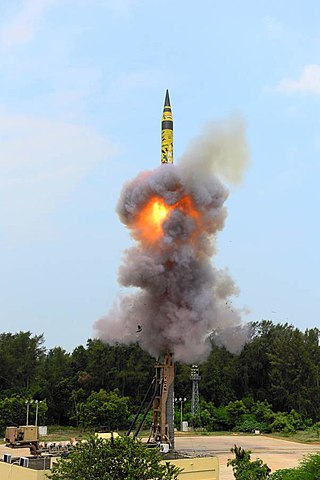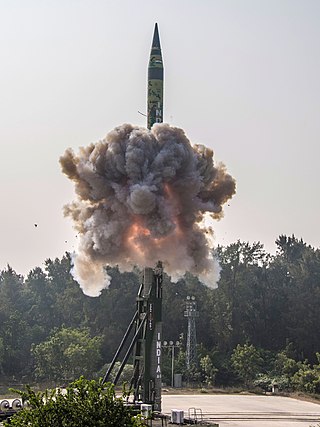
An intercontinental ballistic missile (ICBM) is a ballistic missile with a range greater than 5,500 kilometres (3,400 mi), primarily designed for nuclear weapons delivery. Conventional, chemical, and biological weapons can also be delivered with varying effectiveness, but have never been deployed on ICBMs. Most modern designs support multiple independently targetable reentry vehicle (MIRVs), allowing a single missile to carry several warheads, each of which can strike a different target. The United States, Russia, China, France, India, the United Kingdom, Israel, and North Korea are the only countries known to have operational ICBMs.

The Agni-III is an Indian intermediate-range ballistic missile inducted into service in 2011 as the successor of the Agni-II. It has a range of 3,500 to 5,000 kilometres and can reach targets deep inside neighbouring countries including Pakistan & China.
The Strategic Forces Command (SFC), sometimes called Strategic Nuclear Command, forms part of India's Nuclear Command Authority (NCA). It is responsible for the management and administration of the country's tactical and strategic nuclear weapons stockpile. It was created on 4 January 2003 by the Vajpayee Government. Air Marshal Teja Mohan Asthana became its first commander-in-chief.

Prithvi is a tactical surface-to-surface short-range ballistic missile (SRBM) developed by Defence Research and Development Organisation (DRDO) of India under the Integrated Guided Missile Development Program (IGMDP). It is deployed by India's Strategic Forces Command.

The Integrated Guided Missile Development Programme (IGMDP) was an Indian Ministry of Defence programme for the research and development of the comprehensive range of missiles. The programme was managed by the Defence Research and Development Organisation (DRDO) and Ordnance Factories Board in partnership with other Indian government political organisations. The project started in 1982–83 under the leadership of Abdul Kalam who oversaw its ending in 2008 after these strategic missiles were successfully developed.

Agni-II, is the second strategic ballistic missile of the Agni family envisaged to be the mainstay of the Indian missile-based strategic nuclear deterrence. The Agni-II is a medium-range ballistic missile (MRBM) with two solid fuel stages and a Post Boost Vehicle (PBV) integrated into the missile's Re-entry Vehicle (RV). The Agni's manoeuvring RV is made of a carbon-carbon composite material that is light and able to sustain high thermal stresses of re-entry, in a variety of trajectories. The Agni-IIA is a more advanced version of Agni-II, albeit with more sophisticated and lighter materials, yielding a better range and operating regime. Agni-IIA was later renamed as Agni-IV plugging the gap between Agni-II and Agni-III. While the first test of Agni-IV in December 2010 was a failure, the second test flight in November 2011 was a success Agni-II, developed as part of medium- and long-range Agni series of missile systems, has already been inducted into the Armed Forces.

Chandipur, is a resort town in Balasore District, Odisha, India. The town is located on the shore of Bay of Bengal and is approximately 16 kilometers from the Balasore Railway Station. Chandipur beach is unique in a way that the water recedes up to 5 kilometers during the ebb tide. Due to its unique circumstances, the beach supports biodiversity. Horseshoe crab is also found here on the beach towards Mirzapur, the nearby fishing market and community at the confluence of the Budhabalanga River (Balaramgadi). It is a suitable picnic spot. One of Odisha Tourism's Panthanivas is situated here.

The Agni missile is a family of medium to intercontinental range ballistic missiles developed by India, named after one of the five elements of nature. Agni missiles are long-range, nuclear weapons capable, surface-to-surface ballistic missiles. The first missile of the series, Agni-I was developed under the Integrated Guided Missile Development Programme (lGMDP) and tested in 1989. After its success, the Agni missile programme was separated from the GMDP upon realizing its strategic importance. It was designated as a special programme in India's defence budget and provided adequate funds for subsequent development. As of November 2019, the missiles in the Agni series are being inducted into service. The family comprises the following:

Nirbhay is a long range, all-weather, subsonic Cruise Missile designed and developed in India by the Aeronautical Development Establishment (ADE) which is under Defence Research and Development Organisation (DRDO). The missile can be Launched from Multiple Platforms and is capable of carrying conventional and nuclear warheads. It is currently deployed in limited numbers in Line of Actual Control (LAC) during standoff with China.
The Indian Ballistic Missile Defence Programme is an initiative to develop and deploy a multi-layered ballistic missile defence system to protect India from ballistic missile attacks. It was launched in 2000 after Kargil War by the Atal Bihari Vajpayee government. Testing was carried out and continuing as of 2006, and the system was expected to be operational four years from then according to the head of the country's missiles development programme, Vijay Kumar Saraswat.

Shaurya is a canister-launched hypersonic surface-to-surface tactical missile developed by the Indian Defence Research and Development Organisation (DRDO) for use by the Indian Armed Forces. It has a range of 700 to 1,900 km and is capable of carrying a payload of 200 to 1,000 kg conventional or nuclear warhead. It provides the potential to strike at very-long-range against any adversary.

Agni-I is a short-range ballistic missile that was developed by DRDO of India in the Integrated Guided Missile Development Program. It is a single-stage missile that was developed after the Kargil War to fill the gap between the 250 km (160-mile) range of the Prithvi-II missile and the 2,500 km (1,600-mile) range of the Agni-II. It was first launched from a road mobile launcher at Integrated Test Range (ITR), Wheeler Island, on 25 January 2002. Less than 75 launchers are deployed.

Agni-V is a land based nuclear MIRV-capable Intercontinental Ballistic Missile (ICBM) developed by the Defence Research and Development Organisation (DRDO) of India. The missile has a range of more than 7,000 km. It is a three-stage, road-mobile, canisterised and solid-fueled ballistic missile.
Agni-VI(Sanskrit: अग्नि; IAST: Agni; lit. Fire) is an MIRV-capable intercontinental ballistic missile under development by the Defence Research and Development Organisation (DRDO) for the Strategic Forces Command (SFC) of the Indian Armed Forces.

Prahaar ("Strike") is an Indian solid-fuel road-mobile tactical ballistic missile developed by the Defence Research and Development Organisation (DRDO). Prahaar is expected to replace the Prithvi-I short-range ballistic missile in Indian service.

K-4 is a nuclear capable intermediate-range submarine-launched ballistic missile developed by the Defence Research and Development Organisation of India to arm the Arihant-class submarines. The missile has a maximum range of about 4000 km.

The K family of missiles, is a family of submarine-launched ballistic missiles (SLBM) developed by India to boost its second strike abilities and thus augment its nuclear deterrence. Information about this family of missiles has mostly been kept classified. It is reported that 'K missiles' are faster, lighter and stealthier than their Agni missile counterparts. High Energy Materials Research Laboratory (HEMRL) developed a new formulation of composite propellant that is more efficient and provide greater thrust compare to Agni missile series. The objective behind the development is to make K missile family faster and lighter without compromising on operational range.
India has studied, produced and used various strategic and tactical missile systems since its independence. Decades long projects have realised development of all types of missile systems including ballistic, cruise, anti-ship, air-defence, air-to-air and anti-missile systems. India is one of seven countries in the world with intercontinental ballistic missiles (ICBMs) and one of four countries with anti-ballistic missile systems. Since 2016, India has been a member of Missile Technology Control Regime (MTCR).

Agni-Prime or Agni-P is a two-stage, surface to surface, canister-launched, road mobile and solid-fueled medium-range ballistic missile being developed by India's Defence Research and Development Organisation (DRDO) as the sixth missile in the Agni series. It is intended to be deployed in the operational service of the Strategic Forces Command, and to feature significant upgrades to the composite motor casing, a maneuverable reentry vehicle (MaRV) along with improved propellants, navigation and guidance systems.
















